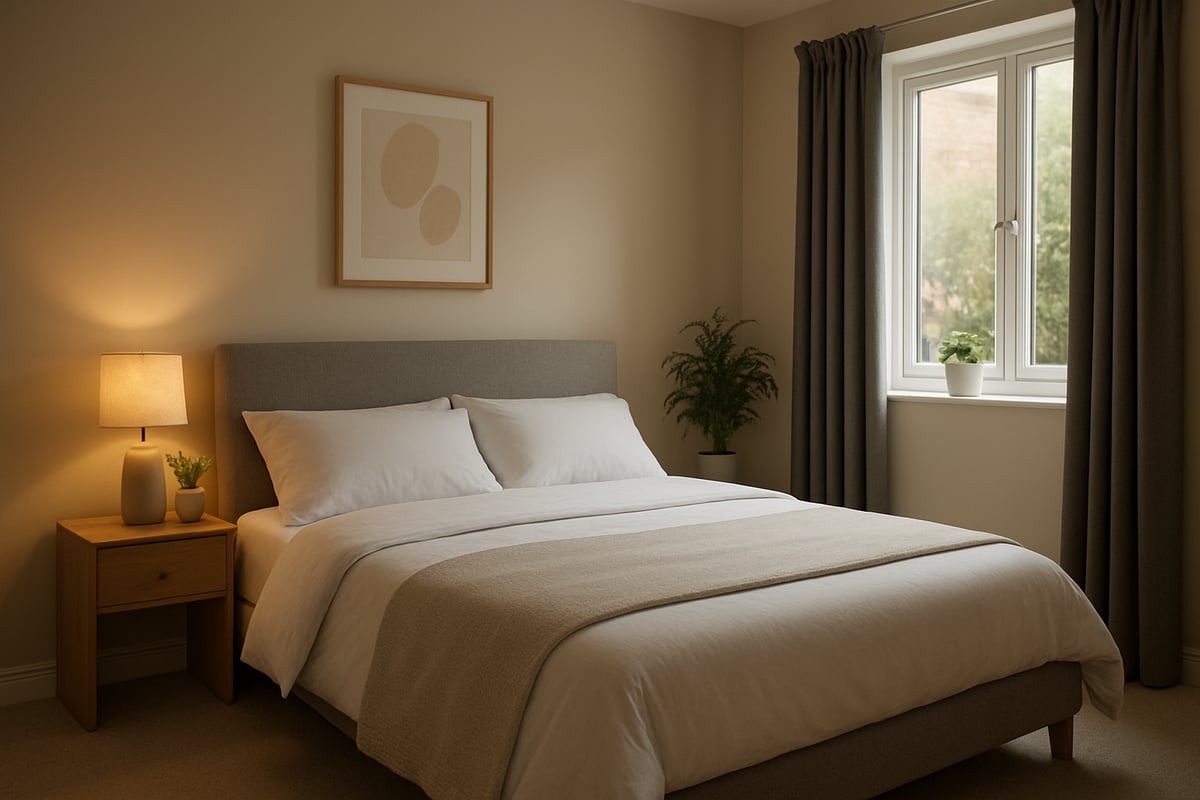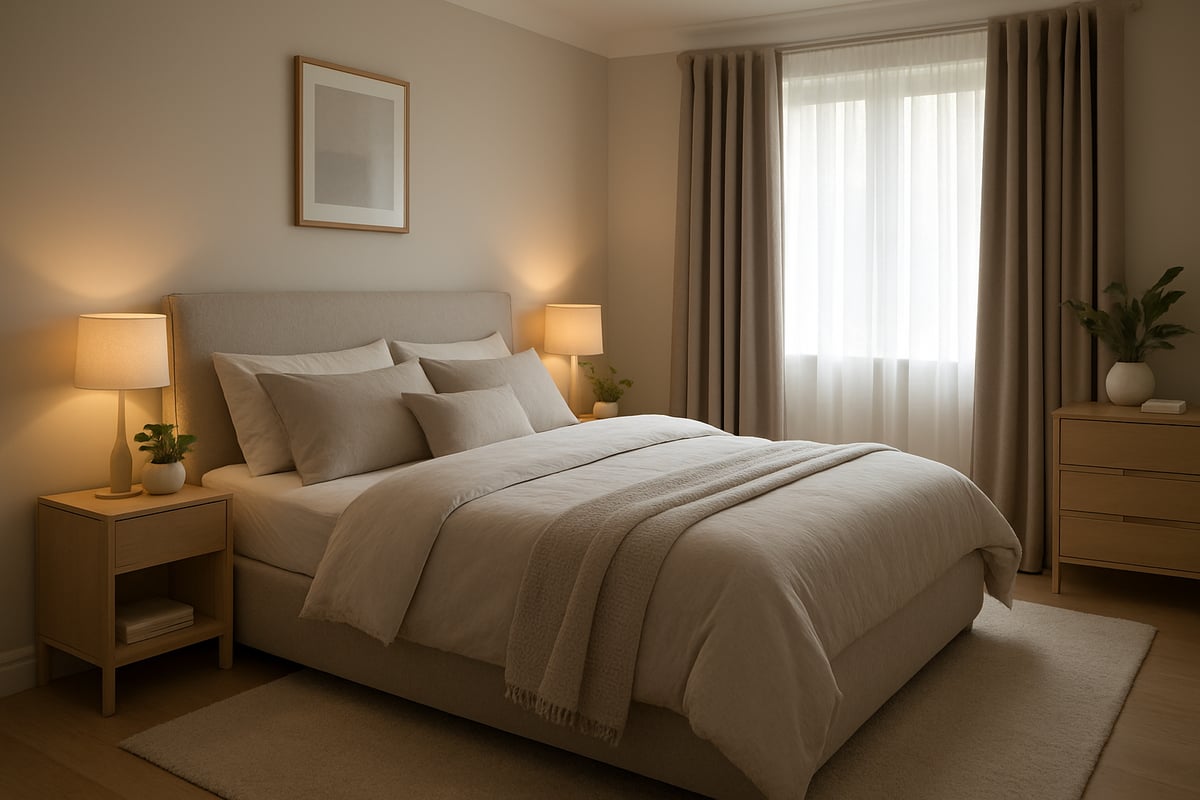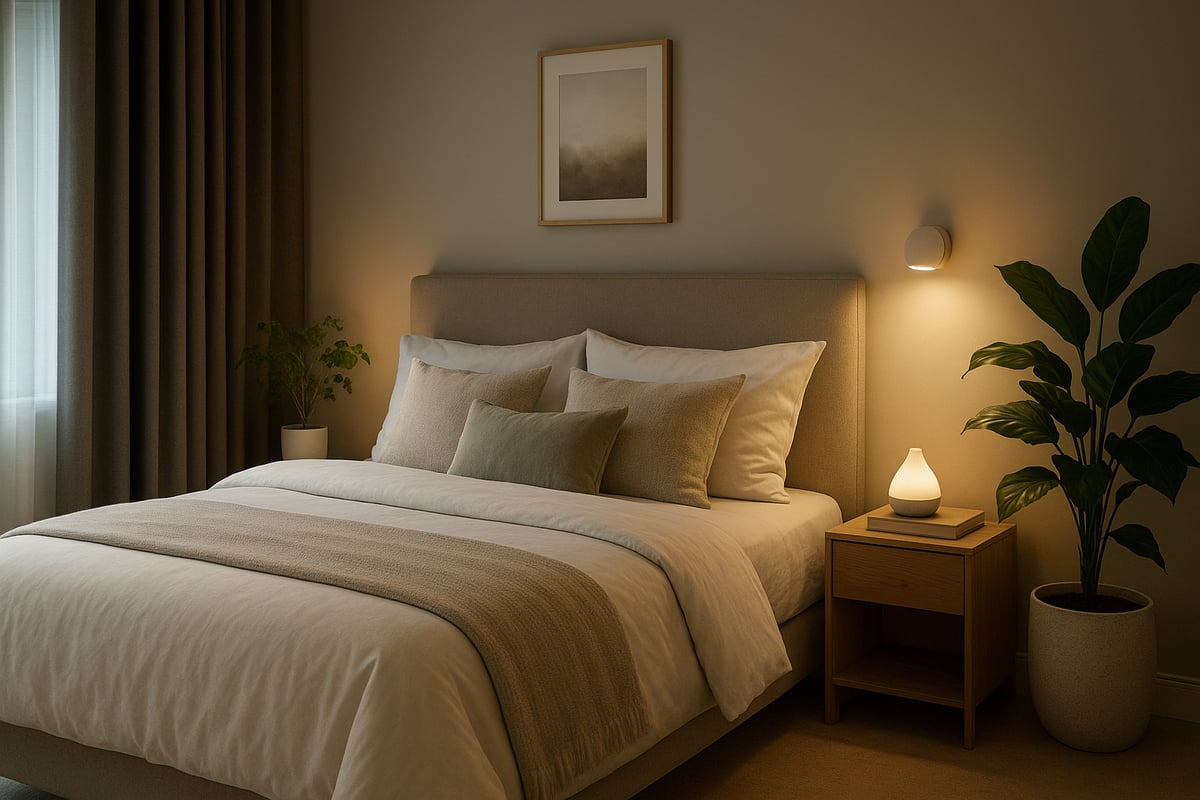Did you know that nearly one in three adults in the UK struggle with poor sleep quality? In 2025, creating the right bedroom and mattress setup has never been more crucial for your wellbeing.
This guide is designed to help you transform your bedroom and mattress choices for truly restful sleep.
We will explore practical tips on bedroom design, selecting the ideal mattress, optimising your sleep environment, and maintaining your setup for long-term health.
Ready to discover proven solutions for better sleep? Read on for expert advice that will guide you every step of the way.
The Science of Sleep: Why Your Bedroom and Mattress Matter
Quality sleep is the foundation of good health, yet many overlook the role their bedroom and mattress play in achieving it. Understanding the science behind restful sleep empowers you to make changes that can transform your nightly experience. Let us explore how your sleep environment, mattress choice, and daily habits impact your wellbeing.

Understanding Sleep Quality and Its Impact
Sleep quality is determined by how well you move through natural sleep cycles, especially deep and REM stages. When your sleep is uninterrupted, your body repairs tissues, consolidates memories, and regulates hormones. Poor sleep, however, can lead to cognitive decline, mood disturbances, and even a weakened immune system.
According to the NHS and Sleep Foundation, adults in the UK typically require seven to nine hours of sleep each night. Many struggle to achieve this, often due to issues with their bedroom and mattress. By prioritising your sleep environment, you can significantly boost both mental and physical health.
The Role of Bedroom Environment in Sleep
Your bedroom and mattress environment directly influence how quickly you fall asleep and how deeply you rest. Factors like light, noise, and temperature all play crucial roles. Studies reveal that around 70% of people report improved sleep in an optimised setting, where distractions are minimised.
Circadian rhythms, your body's internal clock, respond to environmental cues. A dark, quiet, and cool bedroom helps maintain this natural rhythm, supporting quality rest. For a comprehensive approach to crafting an ideal sleep space, see this Guide to Creating the Ultimate Sleepscape, which covers practical steps for UK homes.
Mattress Influence on Sleep Health
The right bedroom and mattress combination is essential for supporting your body throughout the night. Mattress firmness, materials, and support all affect spinal alignment and pressure relief. A comfortable mattress can reduce tossing and turning, leading to more restorative sleep.
Research from the Sleep Council UK highlights that 92% of people believe a quality mattress is vital for good sleep. Choosing hypoallergenic materials can also help reduce allergies, making your bedroom and mattress a healthier place to rest.
Common Sleep Disruptors in the Bedroom
Several factors within your bedroom and mattress setup can disrupt sleep. Clutter creates visual noise, making it harder to relax. Electronic devices, such as smartphones, emit blue light that suppresses melatonin, the hormone responsible for sleep. Statistics show that 60% of UK adults use their phones in bed, negatively affecting sleep quality.
Allergens, like dust mites and pet dander, can accumulate in bedding and mattresses, leading to sneezing or congestion at night. Poor air quality compounds these issues, making it even more important to maintain a clean, allergen-free environment.
The Psychological Connection: Bedroom as a Sanctuary
A well-designed bedroom and mattress setup does more than support physical health; it also nurtures your mind. Calm, inviting spaces have been shown to lower stress and anxiety, making it easier to unwind at night. Colour psychology suggests that soft, neutral tones encourage relaxation.
Incorporating calming decor, such as gentle lighting and minimalistic accessories, can turn your bedroom into a true sanctuary. These aesthetic choices not only improve your mood but also enhance your overall sleep satisfaction.
Designing Your Bedroom for Restful Sleep
Transforming your bedroom and mattress setup is the cornerstone of restful sleep. The right environment supports your body’s natural rhythms and encourages relaxation. By carefully considering colour, layout, organisation, accessories, climate, and personal touches, you can create a sanctuary that nurtures both mind and body.

Choosing the Right Colour Palette and Lighting
Colour psychology plays a significant role in your bedroom and mattress environment. Soft, neutral shades like pale blue, sage, or cream promote calm and relaxation. These tones help lower blood pressure and heart rate, making it easier to unwind at night.
Lighting is equally important. Warm, dimmable lights create a soothing atmosphere, while cool lighting can disrupt your circadian rhythm. Opt for layered lighting using bedside lamps and overhead fixtures. Consider blackout blinds to eliminate light pollution and support restorative sleep.
Layout and Furniture Placement for Optimal Flow
A thoughtful bedroom and mattress layout can transform your quality of rest. Arrange furniture to allow easy movement and avoid blocking natural pathways. Place the bed so you can see the door without being directly in line with it, which is a principle borrowed from feng shui.
Decluttering surfaces and ensuring easy access to your mattress can make nightly routines more peaceful. For detailed advice on how different bed frames contribute to both style and sleep quality, see the Bed Frame Guide for Better Sleep. This supports a harmonious flow and maximises comfort in your space.
Creating a Clutter-Free, Organised Space
A tidy bedroom and mattress area leads to a clearer mind. Use built-in wardrobes, under-bed drawers, or storage benches to keep essentials organised. Avoid letting laundry, books, or electronics pile up, as clutter increases stress and disrupts sleep.
According to the Sleep Foundation, 78% of people report better sleep in a well-organised room. Make tidying a habit and create designated storage zones for frequently used items to maintain order effortlessly.
Incorporating Sleep-Promoting Accessories
Accessories can greatly enhance the comfort of your bedroom and mattress. Blackout curtains block intrusive streetlights, while white noise machines mask disruptive sounds. Air purifiers improve air quality, especially in urban UK homes where pollution or allergens may be an issue.
Consider adding a humidifier if you struggle with dry air, or invest in supportive pillows and duvets that complement your mattress. These elements work together to create an environment that encourages deep, uninterrupted sleep.
Temperature, Ventilation, and Air Quality
The optimal climate for your bedroom and mattress is cool, fresh, and well-ventilated. The NHS recommends maintaining a temperature between 16 and 18°C for best sleep. If your room is too warm or cold, it can lead to tossing and turning.
Open windows regularly to allow fresh air in, use a fan or air conditioning during hot spells, and monitor humidity levels. Clean air supports healthy breathing and helps prevent dust mites from accumulating in bedding and mattresses.
Personalising Your Sleep Sanctuary
Personal touches make your bedroom and mattress feel uniquely yours. Display photos, artwork, or keepsakes that evoke positive memories. Adding plants can purify the air and create a tranquil vibe, while scented candles or diffusers with lavender or chamomile can promote relaxation.
Customising your sleep space enhances emotional comfort, which translates to greater sleep satisfaction. Small details, when chosen thoughtfully, can make your bedroom a true sanctuary for rest and rejuvenation.
Mattress Selection: Finding Your Perfect Match in 2025
Selecting the right bedroom and mattress is a crucial investment in your health and wellbeing. The choices available in 2025 are more diverse than ever, making it essential to understand what sets each option apart. By exploring materials, sizes, and support levels, you can ensure your sleep environment truly meets your needs.
Types of Mattresses and Their Pros & Cons
Understanding the main mattress types is the first step towards the ideal bedroom and mattress setup. Each material offers unique benefits for different sleep styles and preferences.
| Mattress Type | Pros | Cons | Best For |
|---|---|---|---|
| Memory Foam | Excellent pressure relief, contouring | Can retain heat, off-gassing | Side sleepers, joint pain |
| Latex | Hypoallergenic, durable, responsive | Heavier, often pricier | Allergy sufferers |
| Pocket Spring | Good airflow, traditional bounce | Can wear unevenly, less contouring | Back/stomach sleepers |
| Hybrid | Combines foam and springs, balanced | Heavier, more expensive | Couples, all positions |
| Natural Fibre | Eco-friendly, breathable | Less support, premium price | Eco-conscious, hot sleepers |
Matching your bedroom and mattress to your sleep habits can improve comfort and reduce night-time disturbances.
Assessing Mattress Firmness and Support
Mattress firmness is rated from soft to firm, and the right choice depends on your body weight, sleeping position, and any health concerns. A soft mattress suits lighter individuals and side sleepers, while medium options cater to most people. Firm mattresses work best for heavier frames or those needing extra support.
Proper spinal alignment is vital for restful sleep. If your bedroom and mattress do not provide this, you may experience back pain or discomfort. Consider age and mobility too, as older adults often benefit from firmer, supportive surfaces.
Sizing Up: Choosing the Right Mattress Size
Choosing the correct mattress size is essential for a comfortable bedroom and mattress arrangement. Standard UK sizes range from Single (90x190cm) to Double (135x190cm), King (150x200cm), and Super King (180x200cm).
Solo sleepers may opt for a single or small double, while couples often prefer a king for extra space. For children, a single or small double works well as they grow. Always measure your bedroom and mattress area before purchasing to ensure a perfect fit.
Materials and Sustainability in Modern Mattresses
Modern consumers are increasingly prioritising sustainability in their bedroom and mattress choices. Eco-friendly materials such as organic cotton, recycled fibres, and natural latex are now widely available. Hypoallergenic options reduce dust mites and allergens, supporting healthier sleep.
According to Statista 2024, 35% of UK buyers now consider environmental impact when buying a bedroom and mattress. These materials not only benefit the planet but also offer improved breathability and comfort.
Trying Before You Buy: Showrooms, Trials, and Warranties
With so many bedroom and mattress options on the market, testing before you commit is vital. In-store showrooms allow you to try different models, while many online brands offer 100-night sleep trials and generous warranties.
For specific guidance, see the Best Mattress for Ottoman Bed for compatibility advice. Always check trial periods and warranty details, as these can vary. A reliable warranty protects your investment for years to come.
The Sleep Co®: British Craftsmanship and Personalised Sleep Solutions
The Sleep Co® stands out in the UK bedroom and mattress market for its commitment to quality and personalisation. Every bedframe and mattress is crafted in Britain, with custom upholstery options and a focus on longevity.

Customers benefit from private showroom consultations, expert guidance, and professional delivery. The 15-year warranty on bedframes underlines The Sleep Co®'s dedication to lasting value in your bedroom and mattress selection.
Mattress Care and Longevity Tips
Proper care extends the lifespan of your bedroom and mattress investment. Rotate memory foam and hybrid mattresses every three months, but flip only if advised by the manufacturer.
Use mattress protectors to guard against allergens and spills. Vacuum regularly to reduce dust mites, and aim to replace your mattress every 7 to 10 years. A well-maintained bedroom and mattress setup ensures comfort and hygiene night after night.
Building the Ideal Sleep Environment: Step-by-Step Guide
Creating your ideal bedroom and mattress setup requires a thoughtful, step-by-step approach. Addressing each aspect methodically ensures you achieve a truly restful space. Below, follow this practical guide to transform your sleeping environment for optimal comfort and health.

Step 1: Assess Your Current Bedroom and Sleep Needs
Begin by evaluating your current bedroom and mattress setup. Ask yourself: Is your bed comfortable? Are there sources of noise or excessive light? Assess clutter, temperature, and air quality. Create a checklist covering these elements, noting any areas that could be improved. Identifying personal sleep disruptors is essential. Pay attention to how your bedroom and mattress affect your nightly rest. This honest assessment sets the foundation for meaningful changes. Remember, a well-chosen bedroom and mattress can make a remarkable difference in sleep quality and overall well-being.
Step 2: Declutter and Deep Clean
A clutter-free bedroom and mattress space is vital for peaceful sleep. Remove unnecessary items, especially from surfaces and under the bed. Dust and vacuum regularly, targeting areas where allergens can accumulate. Wash bedding and curtains to eliminate dust mites and improve air quality. Organise wardrobes and drawers, using storage solutions to maintain order. A clean, tidy environment not only looks inviting but also supports better sleep hygiene. Make decluttering a routine, ensuring your bedroom and mattress area remains a sanctuary for rest.
Step 3: Optimise Lighting and Temperature
Proper lighting and temperature control are crucial for restorative sleep. Install blackout curtains to block unwanted light, and consider dimmable lamps for a relaxing evening atmosphere. Use a smart thermostat to maintain an ideal temperature, typically between 16 and 18°C, as recommended by the NHS. Research shows that environmental factors affecting sleep quality in summer like heat and humidity significantly impact sleep. Adjust your bedroom and mattress setup to respond to seasonal changes, ensuring consistent comfort throughout the year.
Step 4: Choose the Right Mattress and Bedding
Selecting the best bedroom and mattress combination is a cornerstone of restful sleep. Match your mattress type to your sleep style, health needs, and preferences. Pair it with breathable, high-quality pillows, duvets, and sheets. For more insights, explore how luxury bedding and sleep quality are closely connected. Investing in premium bedding enhances comfort and supports healthy sleep patterns. Regularly review your bedroom and mattress choices to ensure they continue meeting your needs.
Step 5: Personalise with Accessories and Decor
Add personal touches to your bedroom and mattress area to create a calming retreat. Incorporate soothing scents with essential oil diffusers, display meaningful photos, or introduce plants for a touch of nature. Use white noise machines or soft music to reduce external disturbances. Choose decor and accessories that reflect your personality, making your bedroom and mattress space uniquely yours. Personalisation increases emotional comfort, helping you unwind and prepare for restorative sleep every night.
Step 6: Establish a Consistent Sleep Routine
A regular sleep schedule is the final piece in building your ideal bedroom and mattress environment. Set fixed times for going to bed and waking up, even on weekends. Wind down with relaxing activities such as reading, meditation, or gentle stretching. Avoid screens before bedtime to reduce blue light exposure. Consistency helps regulate your body clock, reinforcing the benefits of your optimised bedroom and mattress setup. Over time, these habits will lead to deeper, more rejuvenating sleep.
Maintaining Your Bedroom and Mattress for Long-Term Sleep Health
Keeping your bedroom and mattress in top condition is essential for lasting sleep health. A well-maintained sleep space not only supports physical comfort but also protects against allergens and environmental disruptors. Here’s how you can ensure your bedroom and mattress remain a sanctuary for restorative sleep year after year.
Regular Cleaning and Allergen Control
Consistent cleaning is the cornerstone of a healthy bedroom and mattress. Allergens like dust mites, pet dander, and pollen can build up quickly, impacting your sleep quality and overall wellbeing. Establish a weekly cleaning routine for surfaces, floors, and under the bed. Wash curtains and vacuum carpets monthly to reduce allergen accumulation.
Use hypoallergenic mattress and pillow protectors for an added barrier against dust mites. Air purifiers can further improve air quality, helping to minimise respiratory irritants. Research shows that environmental factors, such as household cleanliness, significantly influence sleep outcomes. For more on the impact of your environment on sleep, see this review of environmental determinants of insufficient sleep and sleep disorders.
Bedding and Linen Care Best Practices
Proper care of bedding and linens is equally important for a fresh and inviting sleep environment. Wash sheets and pillowcases once a week at 60°C to effectively remove sweat, oils, and dust mites. Duvets and mattress toppers should be cleaned every two to three months, following manufacturer instructions.
Opt for breathable, natural fabrics like cotton or bamboo, which wick away moisture and regulate body temperature. Regularly check for signs of wear, such as thinning fabric or loose seams, and replace as necessary. The right bedding care routine supports both the cleanliness and comfort of your bedroom and mattress.
Mattress Rotation, Flipping, and Replacement
Mattress maintenance extends its lifespan and preserves support. Most mattresses benefit from regular rotation every three to six months, which distributes wear evenly and prevents sagging. Some traditional models can also be flipped, but always check the manufacturer’s guidance, as many modern mattresses are single-sided.
Pay attention to signs that your mattress may need replacing, such as visible dips, increased aches, or persistent odours. Data shows that 50% of UK sleepers keep mattresses longer than the recommended 7–10 years, often to the detriment of their sleep quality. Routine maintenance is vital for both your bedroom and mattress.
Seasonal Adjustments for Comfort
Adapting your bedroom and mattress setup for the seasons can dramatically improve sleep comfort. Swap heavy winter duvets for lighter summer options and change curtains to help regulate room temperature. The NHS recommends keeping bedrooms between 16 and 18°C for optimal sleep.
Consider adding or removing mattress toppers based on temperature needs. Monitor humidity levels, especially during winter, to prevent dryness or excess moisture. These seasonal adjustments help maintain the ideal conditions for restful sleep in your bedroom and mattress.
Monitoring Sleep Quality and Making Adjustments
Ongoing monitoring ensures your bedroom and mattress continue to meet your needs. Use sleep trackers or a simple sleep journal to log patterns, noting any disruptions or discomfort. Regularly assess ambient factors like light, noise, and temperature.
If you notice declining sleep quality, it may be time to tweak your setup or try new accessories. Research highlights the strong relationship between physical environment and sleep health, as outlined in this review of physical and social environment relationships with sleep health and disorders. Staying proactive keeps your bedroom and mattress at their best.
Addressing Common Sleep Challenges Over Time
Even with a well-maintained bedroom and mattress, sleep issues can arise. Allergies, back pain, and insomnia are common challenges that may require targeted solutions. Try hypoallergenic bedding for sensitivities, or consider a mattress with better ergonomic support if you experience discomfort.
If sleep problems persist, consult a healthcare professional for tailored advice. Small adjustments—like updating pillows, changing sleep routines, or introducing calming scents—can make a significant difference. Maintaining flexibility ensures your bedroom and mattress always support your evolving sleep needs.
As you start planning your pathway to restful sleep in 2025, every detail in your bedroom matters—from the calming colour palette to the comfort and quality of your mattress. If you’re considering a new upholstered bed or want to ensure your sleep environment is truly tailored to you, the first step is finding the perfect fabric that suits your style and comfort needs. Why not experience the quality and craftsmanship of The Sleep Co® for yourself? You can Order Free Fabric Samples Now and take the next step towards your own personalised sleep sanctuary.


